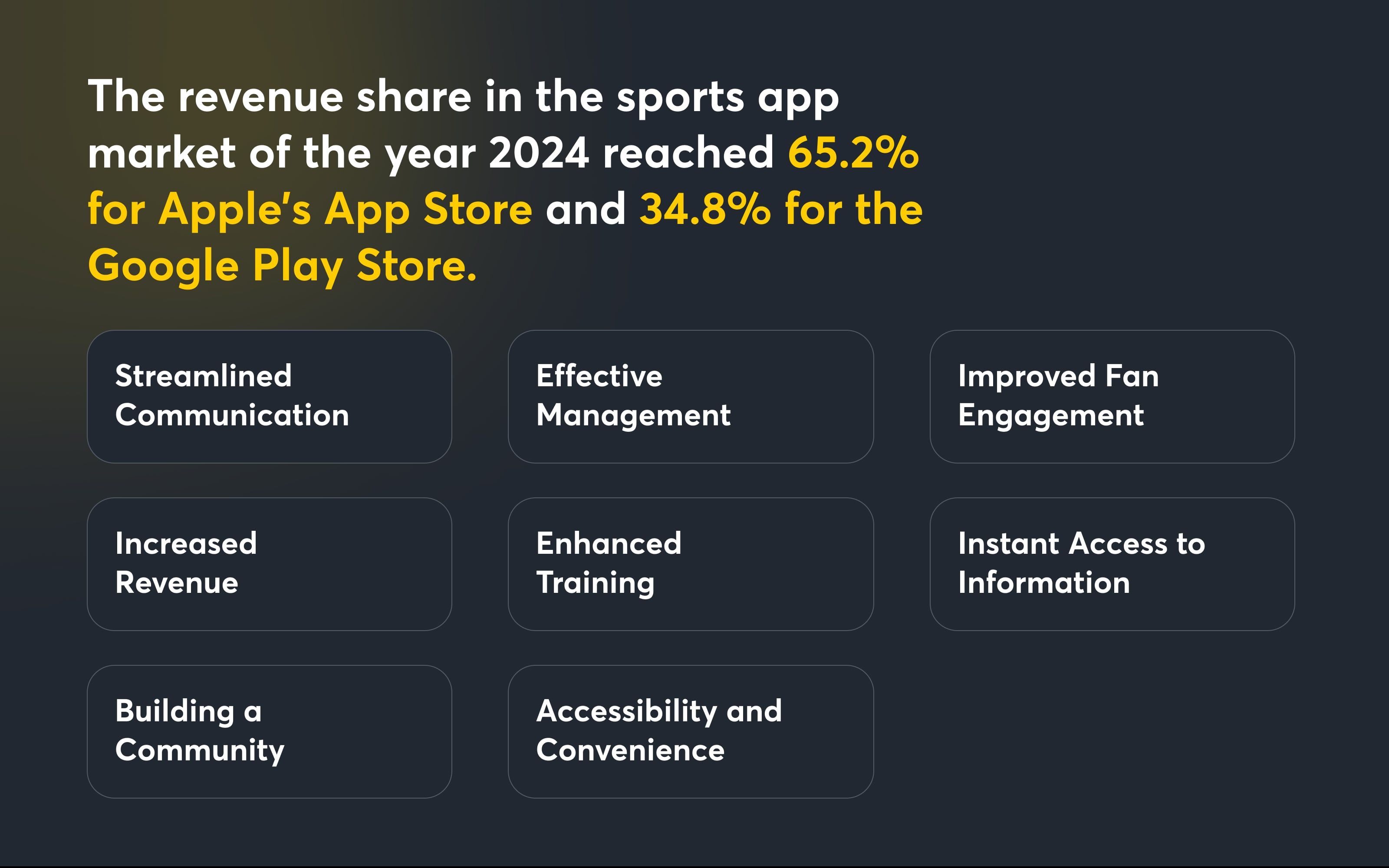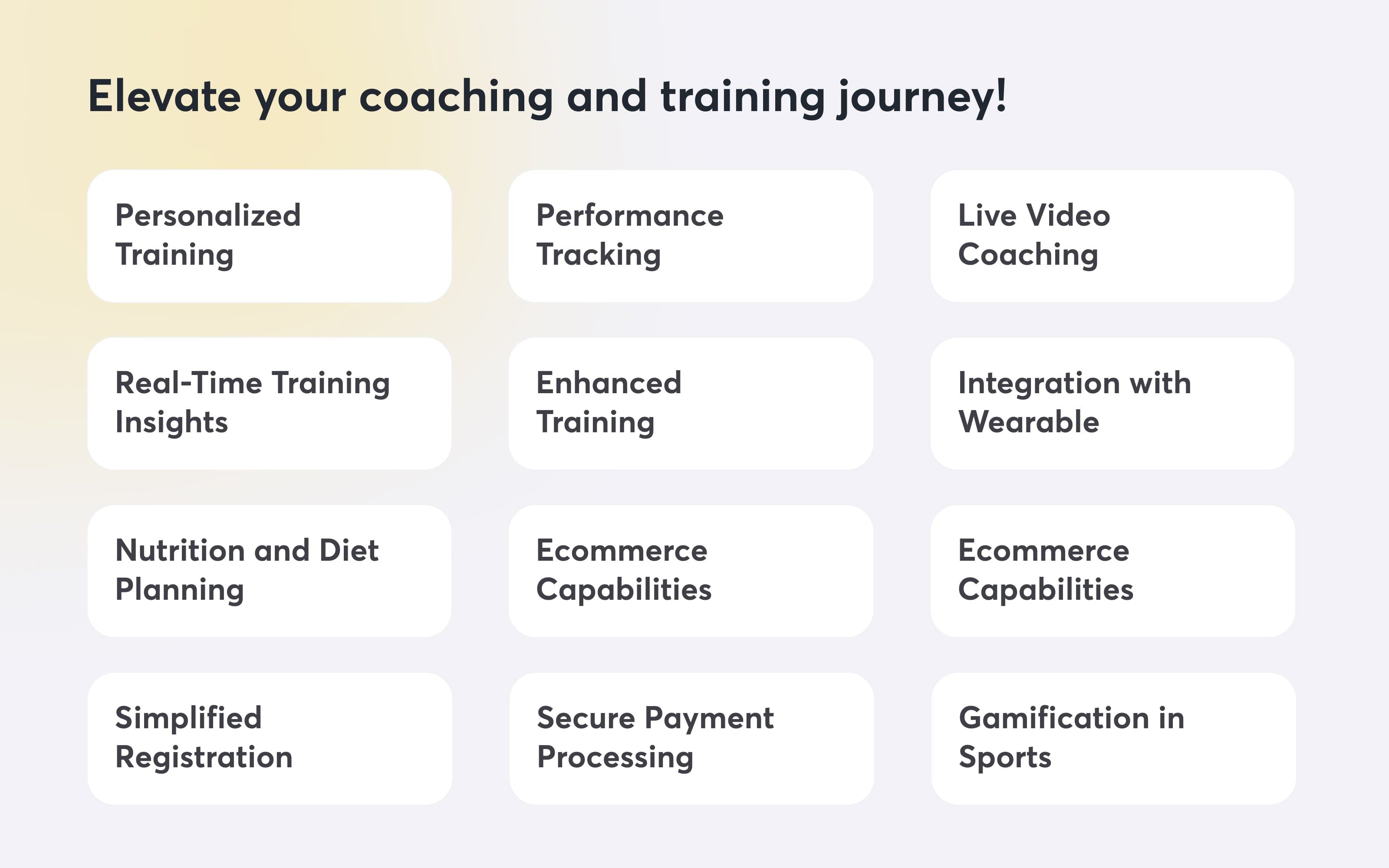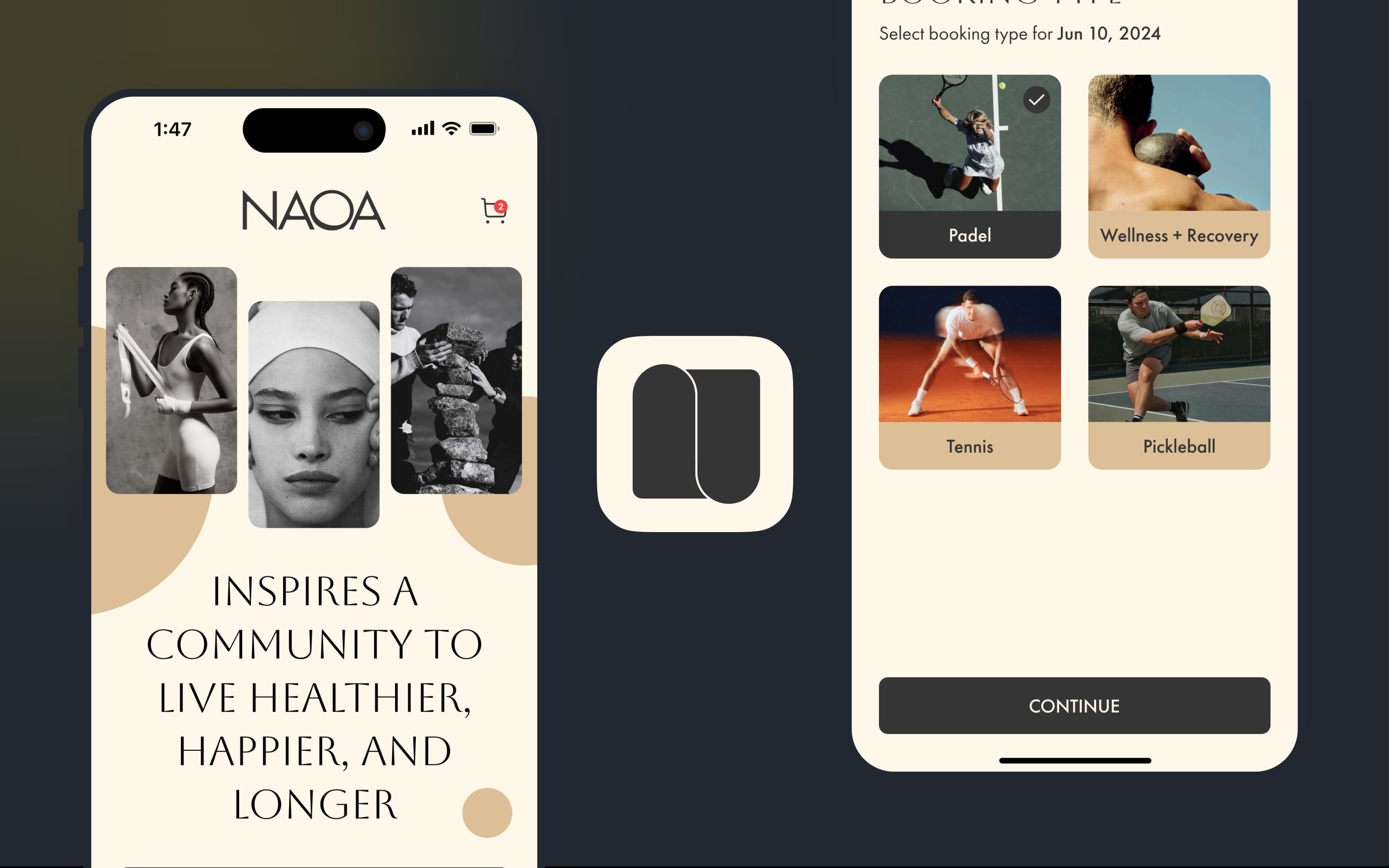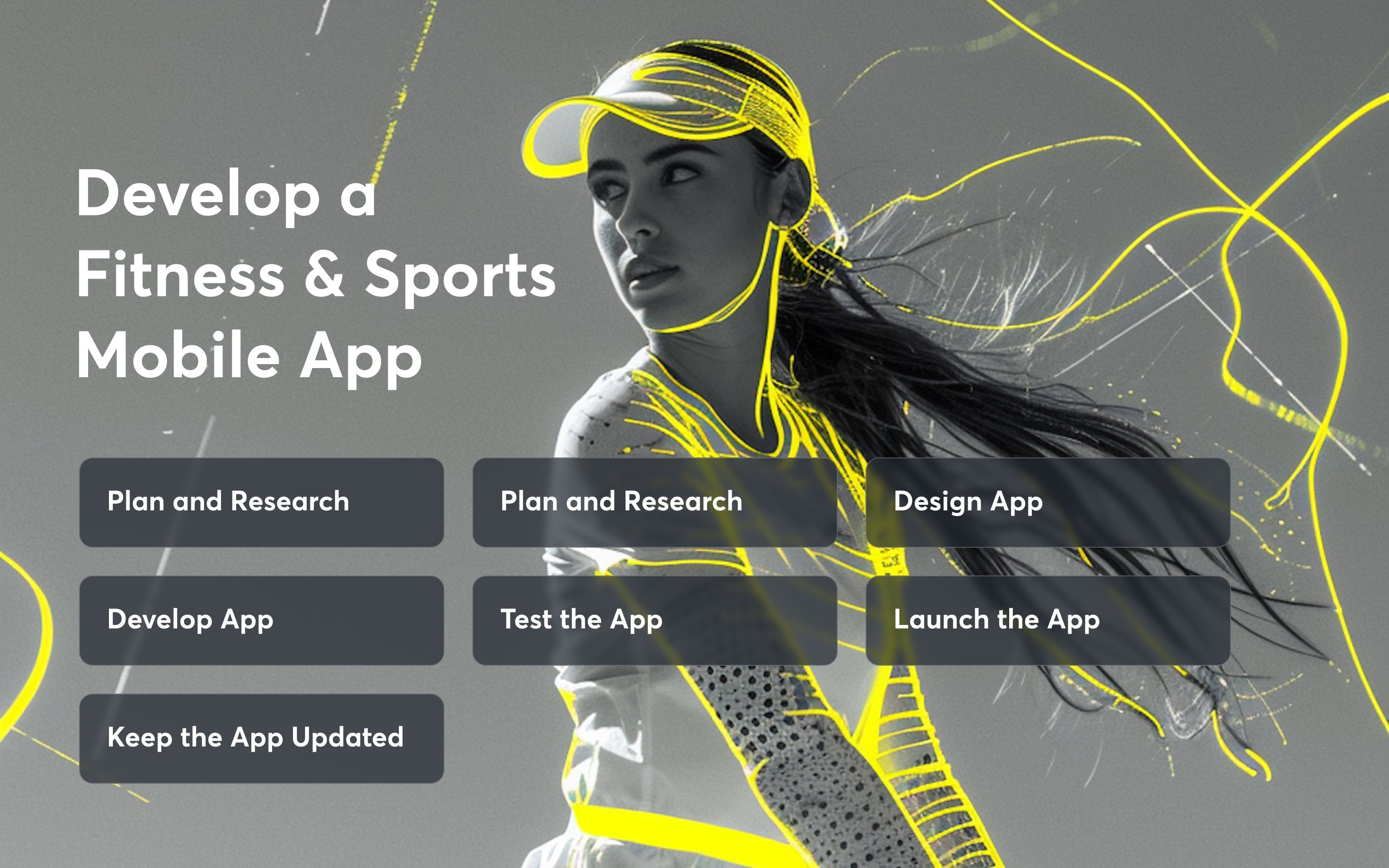With the rise of e-sports and fitness training, sports enthusiasts—including athletes, trainers, coaches, and fitness professionals—are now increasingly utilizing sports and fitness training mobile apps. They can seamlessly begin their fitness journey with a few taps on their smart devices, such as smartphones, tablets, or smartwatches to access personalized workouts, track progress, and connect with virtual coaches and communities.
Moreover, sports organizations and entrepreneurs can also benefit from sports and fitness apps. They can automate operational workflows, such as managing team schedules, automating registration and payments for tournaments, tracking athlete performance data, facilitating online ticket sales, and much more.
Curious to discover more about sports training and fitness apps, and how sports organizations, athletes, and coaches can benefit from these apps? In this blog post, we’ll highlight the key benefits and features of developing a sports and fitness mobile app. Additionally, you’ll learn how to develop a sports app.
Let’s begin!
What is a Fitness and Sports Training App

If you’re a fitness training expert, imagine a digital platform that allows you to conduct online training programs, create personalized workout plans, and track performance in real-time—this is what a fitness and sports training app lets you do. Likewise, an athlete can receive virtual training and coaching sessions from the comfort of their homes using a sports training app.
Additionally, the AI-built sports training app can track your workout habits and daily physical activities to recommend personalized workout plans. What’s even more interesting is that a sports training app integrated with wearable devices can monitor heart rate, calories burned, sleep patterns, and workout intensity in real-time. This helps athletes maintain their fitness and share their daily workout progress with coaches to receive supportive feedback and guidance.
Key Benefits of Fitness and Sports Training Apps

Developing sports coaching apps is becoming pivotal within the sports industry, which comes with a lot of significant benefits, including enhanced athlete performance, streamlined training processes, improved data-driven decision-making, and boosted fan engagement. It can create new revenue opportunities for sports organizations and trainers.
According to Statista, the revenue share in the sports app market of the year 2024 reached 65.2% for Apple’s App Store and 34.8% for the Google Play Store. Moreover, the fitness market app revenue is estimated to reach US$6.86bn by the year 2024. Let’s explore the key benefits of fitness and sports training apps in the section below:
1. Streamlined Communication
Communication plays a vital role in fitness and sports apps, it provides seamless communication and collaboration between athletes, trainers, and team members. Whether, through in-app messaging, video calls, or live updates, everyone stays connected in real-time. Coaches can quickly send instructions, workout modifications, or feedback, while athletes can ask questions and share their progress with their coaches.
2. Effective Management
Sports coaching apps help trainers and athletes stay organized by managing schedules, workouts, and events in one place. Athletes can easily access their training programs, set goals, and track their progress, while trainers can manage multiple clients efficiently. The app can also handle tasks like team rosters, game schedules, and reminders. It reduces the chaos of manual planning and improves the workflow for both individuals and teams.
3. Improved Fan Engagement
Sports organizations can improve their engagement and interaction with fans using sports and training apps. Features like live updates, match highlights, exclusive content, and social media integration enhance their experience. Moreover, fans can follow their favorite teams, interact with other fans, participate in polls, and even attend virtual events.
4. Increased Revenue
Fitness and sports coaching apps open up potential ways to generate more revenue through subscription models, pay-per-view sessions, in-app purchases, advertising, and sponsored content on digital platforms. These methods allow them to generate revenue by offering exclusive workouts, training plans, live coaching sessions, and premium content to their audience. This expanded monetization strategy helps individuals alike grow their sports businesses while delivering valuable services.
5. Enhanced Training
With personalized workout plans, video tutorials, and performance tracking, sports apps elevate the training experience. Athletes receive tailored programs based on their fitness levels, goals, and sport-specific needs. Trainers can monitor progress through real-time metrics, adjust routines, and provide immediate feedback. This enhanced training, powered by data-driven insights, ensures athletes are continuously improving while reducing the risk of overtraining or injury, leading to optimized performance.
6. Instant Access to Information
Developing a sports mobile app is a great way to help athletes and trainers get instant access to essential information such as training schedules, nutrition plans, performance metrics, and injury prevention tips. This on-demand access eliminates the need for constant check-ins or manual tracking. Whether looking for a workout routine or analyzing past performance, users have everything they need at their fingertips.
7. Building a Community
Athletes, trainers, and fans—all can connect on a single platform that fosters a sense of community building and engagement. Features like group challenges, social feeds, and messaging allow users to motivate and support one another. Athletes can share their achievements, while trainers can create communities of clients who work toward common goals.
8. Accessibility and Convenience
Accessibility and convenience are key benefits of sports mobile apps. It allows athletes and trainers to access workouts, training programs, and performance data anytime, anywhere. Whether you're at the gym, at home, or traveling, users can easily track progress, follow workout routines, or communicate with trainers on the go. This flexibility eliminates the need for in-person sessions or paper-based plans.
How Fitness and Sports Apps are Revolutionizing Training and Performance

Let’s take a look at how fitness and sports coaching apps can help you elevate your coaching and training journey and transform the sports industry.
1. AI-Driven Personalized Training Programs
Each athlete’s body type and fitness level is unique, requiring custom workout plans tailored to individual needs. This is where an AI-based fitness and sports app works wonders! The AI functionality within the app can suggest targeted exercises, optimal intensity levels, and progression plans by analyzing user behavior, workout history, and real-time data.
Over time, the app dynamically adjusts workout plans as users progress to ensure continuous improvement by modifying exercises, intensity, and duration. Moreover, these programs can be adapted for specific sports or training styles that enable both beginners and experienced users to benefit from structured, effective workout plans.
2. Performance Tracking and Analytics
Tracking performance and sharing it with your fitness coach is essential—but how do you measure progress effectively? The quick answer: through a sports coaching app. Modern fitness apps leverage advanced analytics tools that can seamlessly collect, analyze, and display metrics like speed, endurance, strength, and recovery rates. Using data visualizations and performance reports, athletes can track improvements, set new goals, and adjust their training plans.
Similarly, trainers can review data to personalize workout plans, focusing on areas needing development. By comparing current stats with past performance, users gain insights into their progress, which fosters a deeper understanding of what training adjustments are needed for optimal results.
3. Live Video Coaching
E-sports and fitness have surged in popularity, bringing new opportunities for virtual training. Fitness professionals can now access remote coaching and live training sessions through sports apps, enabling real-time interaction with coaches. They can enroll in live training programs, receive instant feedback on form and technique, and participate in interactive sessions.
This feature of the sports and fitness app eliminates geographical barriers, allowing athletes to train with top coaches worldwide and fostering a more engaging and motivating training experience, all from the convenience of their own space. Moreover, in-app tools like screen annotations and slow-motion replays to further enhance learning. Additionally, session recordings can be saved for future reference, enabling athletes to review and refine their performance continually.
4. Real-Time Training Insights with Widgets
Mobile app widgets in sports training apps provide quick access to essential features and real-time updates right from the home screen. With widgets, users can instantly view stats like daily step count, calories burned, or workout progress without opening the app. They can also access shortcuts to start a workout, track hydration, or log meals, which enhance convenience for athletes on the go.
Furthermore, widgets can display motivational quotes, training reminders, or weekly goals, keeping users focused and engaged. By offering timely insights and encouraging healthy habits, sports training apps make it easier for users to maintain consistency in their training routine and reach their fitness goals.
5. Integration with Wearable Devices
According to Statista, the United States had around 65 million fitness tracker users in 2023, with most relying on smartwatches. This number is projected to rise steadily, surpassing 71 million by 2028. These stats highlight the growing importance of wearables and how fitness enthusiasts can seamlessly connect them with a sports app to track real-time health metrics, including calories burned, step counts, sleep patterns, and much more. This data enables a more holistic view of their health, allowing them to monitor their performance and make informed decisions about their training.
Overall, syncing wearables with fitness apps facilitates a more data-driven approach, which helps athletes prevent injuries, optimize workouts, and achieve better long-term outcomes through personalized insights.
6. Nutrition and Diet Planning Tools
Manually managing a diet plan can be a hectic task, especially when an athlete who has a busy schedule or travels frequently. Sports and fitness app developers integrate the nutrition and diet planning tools within the sports app to help users track their food intake, set dietary goals, and maintain balanced nutrition that complements their fitness efforts.
Users can set dietary restrictions, view food recommendations, and track progress towards nutritional goals, making it easier to sustain a healthy lifestyle alongside regular exercise, which maximizes fitness results. Additionally, trainers can offer diet plans through the app, enhancing the impact of online training.
7. Ecommerce Capabilities
Wouldn’t it be any surprise when a sports mobile app, which is used for fitness and training can also let you shop your favorite sportswear? That’s what the best part of sports and fitness apps is- An all-in-one platform used for training and shopping. Using e-commerce features in fitness apps provides a convenient way for users to purchase relevant products, such as supplements, workout gear, apparel, and fitness equipment.
By offering a built-in marketplace, fitness apps create additional revenue streams and simplify the buying process for users. This functionality allows athletes and fitness enthusiasts to find and purchase everything they need within the app. It improves user experience and creates a seamless ecosystem that supports both training and lifestyle needs on the same platform.
8. Simplified Registration
Automated registration streamlines the onboarding process, making it faster and easier for users to embark on their fitness journey. With the use of simplified forms, single sign-on (SSO) options, or social media integrations, users can register in seconds without tedious data entry. These apps may also allow pre-filled health and fitness information from connected devices, instantly personalizing the experience.
With automated registration, users can immediately access training programs, book sessions, or join virtual classes, reducing administrative burden. This seamless approach enhances user convenience and encourages higher engagement rates, making it easier for users to commit to their fitness goals from day one.
9. Secure Payment Processing
With integrated payment options, sports apps simplify financial transactions for users. Whether it’s paying for a premium training plan, registering for a competition, or purchasing team merchandise, payments can be processed quickly and securely through the app.
Users can register, fill out forms, make payments, and receive confirmation in a few clicks. This convenience reduces friction in the payment process, encourages purchases, and improves the overall user experience, making financial management easier for both individuals and organizations. Moreover, AI-driven encryption prevents fraudulent activities and ensures that users' data and payment details are safeguarded at every step.
10. Gamification
Sports and fitness app developers can incorporate gamification in sports mobile apps to boost engagement and keep the user motivated. Adding fun, competitive elements like rewards, challenges, and leaderboards encourages users to stay consistent with their workouts, achieve goals, and compete with others.
Progress badges and social sharing further enhance the experience, encouraging interaction and fostering a community around fitness. Besides, gamification can increase app retention and download rates. It unlocks more opportunities for user loyalty, premium memberships, and in-app purchases. This approach to sports training app development makes fitness enjoyable for users and at the same time enables you to generate more revenue for your business.
Cygnis’ Case Study for Sports and Coaching App: Country Club Management (NAOA) Case Study

Cygnis partnered with the NAOA, a sports membership club, to develop a comprehensive sports and coaching app for country clubs. Designed to enhance member engagement, scheduling, and communication, the app delivers a streamlined experience for both club managers and members. Featuring real-time booking, event registration, and activity tracking, the NAOA app modernizes club operations, transforming how country clubs manage memberships and organize events.
This case study showcases how Cygnis integrated advanced functionalities to automate membership management and simplify workflows. By incorporating data analytics and user feedback tools, the app empowers coaches to effectively monitor athletic performance and customize training plans for athletes, fostering an interactive and data-driven coaching environment.
How to Develop a Fitness and Sports Mobile App

If you’re ready to build a sports and fitness training app, here’s a quick guide to get you started:
1. Plan and Research Your App
When developing a fitness and sports mobile app, the first step you need to take is to plan out the overall concept. Identify your target audience—whether it's athletes, trainers, or fitness enthusiasts—and define the core features that will meet their needs. If you’re a startup, consider building an MVP to test your concept with essential features only and gain real-time feedback. You can build your user persona to gain a clear understanding of your target audience’s needs, goals, and pain points. This helps in developing a user-centric sports training app that resonates with their needs.
2. Choose Sports & Fitness App Developers
Next, choose skilled sports & fitness app developers to bring your app vision to life. Look for someone experienced in building sports or fitness apps and check out their portfolio of previous projects to ensure they can deliver the functionality, performance, and design you envision.. Also look for reviews and ratings, as it will enable you to make the right decision to choose the best app development company that has a team of passionate mobile app developers with great expertise and knowledge in building modern sports coaching and training apps. Once selected, briefly coordinate your project requirements and expectations to build the app of your dreams!
3. Design the Fitness and Sports App
Focus on creating an intuitive, user-friendly design for your app. Work closely with a designer to create a visually appealing app that reflects your brand identity. The design should cater to both beginners and experienced users, making it simple for them to find workouts, track progress, or interact with other users. Colors, fonts, and visuals should reflect your brand while maintaining a clean and professional appearance to provide users with a pleasant experience every time they open your app.
Learn more: How to Create a Visually Appealing App that Engages and Inspire Users
4. Develop the Fitness and Sports App
Once the design is finalized, the development phase begins. Your developer will turn your vision into a functional app, ensuring that all core features—like personalized workout programs, real-time tracking, or social sharing—work seamlessly. During this stage, focus on optimizing performance, security, and user experience. Incorporate tools that allow easy integration with wearables or other fitness devices. This stage brings the blueprint to life, transforming your ideas into a fully operational sports mobile app.
5. Test the App
Before launching, thoroughly test your app to ensure it functions smoothly. Conduct beta tests with real users to identify any issues with usability, performance, or bugs. Make sure all features, from data tracking to live video coaching, work correctly and that the app performs well on different devices and operating systems. Testing is a crucial step to ensure your users have a seamless experience, and it helps you avoid glitches or user frustration once the app goes live.
6. Launch the App
Once testing is complete and any issues have been addressed, it's time to launch your app. Announce the launch to your target audience—whether through social media, email campaigns, or partnerships with influencers. Highlight the key features and benefits of the app to attract downloads. Ensure your app is available on major platforms, such as iOS and Android, and provide clear instructions on how to use its features. A successful launch will help you start building an active user base and gain early feedback.
7. Keep the App Updated
Your work doesn’t stop after launch. Regularly update the app with new features, improvements, and security patches based on user feedback. This keeps your audience engaged and ensures that your app stays competitive in the market. You can add fresh content, fix bugs, and introduce new tools like challenges or nutrition plans to retain users and attract new ones. Staying on top of updates shows your commitment to providing value and delivering the best possible experience for athletes and trainers alike.
Conclusion
Mobile apps have revolutionized fitness and sports training by providing athletes and trainers with powerful, accessible tools to enhance performance. Through personalized training programs, real-time data tracking, and remote coaching options, these apps enable users to stay connected to their goals anytime, anywhere. Features like gamification, wearable integration, and live video coaching boost motivation, accountability, and engagement, making training more enjoyable and effective. As the demand for convenience and customized experiences grows, sports & fitness training apps will continue to evolve, offering more sophisticated solutions that empower athletes and trainers alike to push boundaries, stay inspired, and achieve peak performance.










